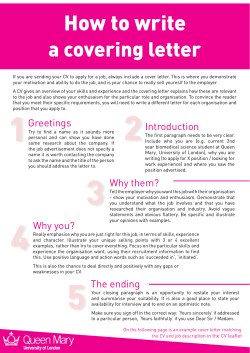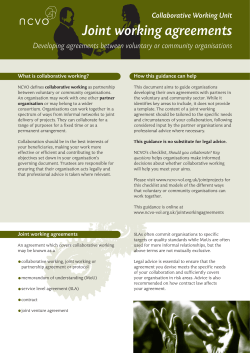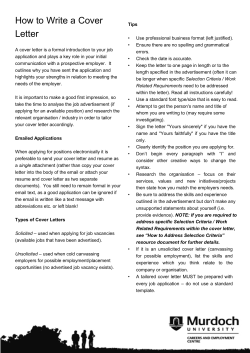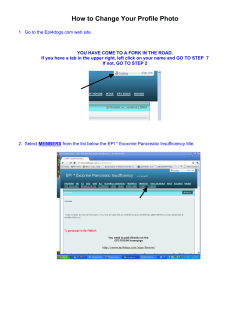
Document 205517
Contents 1. Introduction 1 2. Why publicity? 1 3. What is the media? 1 Television 1 Radio 1 Print 1 Online 1 4. Planning 2 5. Sparking local media interest 2 Frame your story 2 6. Building a media database 2 Identify the media 2 7. Working with the media 3 Talking to the media 3 8. Media tools 4 Developing media tools 4 Media alerts 4 Media releases 4 Sending your release 5 Other media tools 6 9. Other media considerations 8 Distribution 8 Your photos 8 10. What to do when the media contact you about your event 10 11. Who looks after media tasks? 10 Coordinating 10 Speaking 11 Writing 11 12. And remember… 11 13. Glossary 12 1. Introduction This guide offers ideas on promoting your project both in your community and through the local media. It highlights what the media might look for in a news story as well as offering handy tips on how to promote your upcoming events. Receiving positive media coverage for your project can have a lasting impact on the work that you do. The media enables the public to recognise what you have achieved and what your key messages are, making your audience more likely to support your project. 2. Why publicity? If you have a unique organisation or event, why keep it a secret? The media is always looking for new stories so it’s important that you know how to work with them to get your story out there. Publicity gained through the media often comes at little or no cost and can add benefit to the project and your organisation. 3. What is the media? The media industry is made up of many different mediums. The four most prominent are: Television Commercial and non-commercial television. Each type of channel will usually have a program or segment which covers or promotes community events. Radio Commercial, non-commercial and community radio stations. Radio is an effective medium to promote your activities as they advertise local events and talk about local issues. Print Local and national newspapers, magazines, brochures and poster pullouts. Print advertising can spread key messages through an article or an advertorial story. An article is a form of publicity that does not cost anything, as it is the core business of newspapers and magazines. An advertorial is bought space made to look like an article. Online Websites, blogs, podcasting and event diaries. Online media has become a favourable way to get messages out to the public. It is easily accessible and usually free. You can advertise your event on other websites or have conversations about your program with others on blog sites. Publicity guide - How to promote your community relations project through the media 1 4. Planning It is important to map out the key messages and objectives of your organisation’s project. Gather information on what your project is about, its aims and goals, target audience and facts you think might be handy. Keep them close by. Draw up a list of local media organisations including television, radio, print and online. 5. Sparking local media interest The media is generally interested in what will grab the public’s attention. When it comes to community organisations the local media is interested in how the story or event affects the local community. Frame your story Determine the date, time, place and details of the event, as well as the level of awareness you want to raise and to which audience. Then identify why your story is newsworthy. Be clear about what you are offering the media and ensure your information is: • logical, allowing journalists to assess its newsworthiness • factual, with interesting figures and anecdotes which bring it alive • timely, meeting media deadlines • newsworthy, makes good TV, article or images. Whether you have a story for the local news station or you would like your story featured in the newspaper, it is important that you make your story relevant to the audience of each media organisation. There are many ways of informing your media contact about your product. 6. Building a media database Identify the media Check your library for Margaret Gee’s Media Guide, a directory showing media outlets in Australia. Draw up a list of newspapers, radio and television stations in your local area, including community and radio stations. Call the media outlet to find out which editor, producer or reporter would be most likely to be interested in your plans. 2 • The right contact person for television is usually the producer or researcher. For news items it is the chief of staff. • Your radio contact can be found by calling the station switchboard or having a look in the white pages. • For newspapers and other publications the editor or chief of staff is usually the person you will need to contact. Once you have found the right media contact to talk to, it is best to put this information into a database. The database can be a simple Microsoft Excel spreadsheet or a Word document, whichever you feel more comfortable with. The database should display: • the media organisation • target audience – who you intend to deliver your messages to (such as teachers, students, government) • editor/producer • telephone • email • date sent • response. 7. Working with the media Journalists and other media contacts receive a large number of media requests, media releases and media alerts daily. It is best to know how you can make their job easier. Some handy tips for building media contacts are included below: • Become a reliable source of information and provide your information on time. • Make the effort to get to know your local media—small gestures, like spelling their names correctly and being polite, mean a lot. • Make contact on a regular basis—this will enable you to get to know them on a more personal level and establish a rapport. It is important that the relationships you build with the media are maintained. This enables you to go back to your media contact when a new story evolves. Talking to the media Once you have your list and know what you are going to say, call the producer, editor or reporter to explain your story and highlight why you think it will interest their listeners, readers or viewers. Publicity guide - How to promote your community relations project through the media 3 You can have a face-to-face/telephone meeting or email/letter exchange. Start a telephone conversation by clearly stating who you are, the group you represent and why you are calling. Ask the reporter, ’Is this a good time for you?’ If they say no, arrange a time to call back. Journalists like advance notice so talk to them well before their publishing and broadcasting times. 8. Media tools Developing media tools You can publicise your activities through: • media releases • articles • community newspapers and newsletters • websites. Media alerts A media alert is a simple, one-page invitation to the media to attend your event. Your media alert should include: • a brief description of your event • details of the event, including when, where, duration and who is attending • details of a contact person • an indication of photo opportunities. If you send out an alert before speaking to a journalist, they can have something in their hand before they speak to you. Media alerts can be faxed, posted or emailed 24 to 48 hours before an event to allow individuals to review and ask for any additional information and organise coverage of the event, including putting in a newsroom or find out further information. You should always check the deadline and any in-house requirements of the publication. Media releases A media release is a one page document that pitches your event/story to the media. To write a media release: • write down all of the major points relating to your story • place your points in order from most important to least • find the human interest element in the story • market your organisation by using your letterhead and clearly mark it ‘Media release’. 4 Sending your release Proof read your media release and ask a colleague to have a look and make sure the key facts like the date and time of the event are correct. The final release can then be sent by email, post or fax to the media outlet you have chosen. Writing your release Below is a chronological format and explanation for drafting your media release. Organisational logo Media release Date issued Headline – media releases start with a short, attention grabbing headline Set the scene – briefly discuss what’s happening (link it to the title) What, why, who, when, where – a general statement about what it is that’s happening and why your organisation is involved. It’s a good opportunity to insert a quote to support ‘what & why’ as well as statistics and general information about your area. Apply the points of interest you wrote earlier. More information – if relevant, state how the general public can find out more about the event or organisation. Photo opportunities – write a statement identifying these. Contact details – insert contact name, phone number, email address and website if applicable. Publicity guide - How to promote your community relations project through the media 5 Other media tools Media kit A media release is ideal for faxing and emailing to media organisations or to alert them to news items and feature stories. However, a media kit can provide more detail for upcoming events. When inviting particular media organisations to your event provide them with a media kit at least four days before your event that can include: • a copy of your media release • a running sheet of your event (a program with times and brief descriptions of what will happen) • background information on your project • information on relevant community trends • photographs and any previous published articles you may have about your program • any logos that your organisation is associated with • details of your contact person. Written articles Generally newspapers and magazines do not require you to write articles for them, they usually require background information. However, smaller publications or newsletters may ask you to prepare an article. Make sure you ask how long the article should be and if they want photos. While an article is different to a media release the process is quite similar. You must think about the message you want to get across and the kind of angle you want for your story. Do you want to focus on the local issue, the event or the community that surrounds your project? It’s also a good idea to use your organisations letter head and clearly mark ‘Media release’. Once you have thought about the angle of your story you should write down all of the important information you want to include in order of importance. You should then write your article in that order. Newsletters and brochures Newsletters are inexpensive, effective and will draw attention to your event. By sending out a one page newsletter about what is happening within your project on a regular basis, you can build relationships with individuals, media and potential audiences. They can be emailed or printed and usually display your organisation’s name and logo. It’s a good idea to keep it simple, around four A4 pages in length should be enough. 6 What you can include in your newsletter: • news articles—past or future events that your organisation is involved with • feature articles—focus on a particular aspect of your project • personality profiles—this is great for profiling individuals in your organisation or someone that had a great impact on a project or event • good news/success stories • puzzles—you can include your organisation’s key messages in puzzles and quizzes • coming attractions and events. Photos will help attract your reader’s attention. Make sure every image has a caption that explains who is in the photo and what they are doing. Always include a ‘call to action’, for example a box with text that says ‘Please pass this newsletter on to your friends and colleagues’ or ‘For more information on our organisation or project contact xxx’. Community Service Announcements Community Service Announcements (CSAs) are short messages that promote a cause, activity or event that is thought to be of service to the community. Many television and radio stations set time aside to broadcast CSAs free of charge. Many newspapers, particularly suburban and regional papers, publish their version of CSAs in free community ‘What’s on’ columns or ‘filler’ ads. To find out how the radio station or TV station prefers CSAs to be prepared and submitted, contact the switchboard or visit their website. Ask for the guidelines and try to follow their advice closely. You should send in your announcement about three weeks before the event and include: • who is holding the event and what the project is about • what sort of event is planned • where the event is to be held • when will it be held (date and times) • why the event or project is happening. Publicity guide - How to promote your community relations project through the media 7 9. Other media considerations Distribution Depending on the time of your event or the deadline for a story there are various ways to deliver your media products. Mail and fax are a good idea for media releases and alerts. Mail is usually the best option for a media kit and general correspondence with your media contact should be by phone and email. It’s important to target relevant media organisations that best match the members of the community you wish to reach. There are several resources available that list key media organisations and contacts. Your photos Photos are a great way to sell your story and usually have a greater impact when securing media space. You don’t necessarily need a professional photographer to get great photos. Here are some handy hints for when you take your snaps: Incorrect • Your photos should always show people doing something, not just standing around looking at the camera. Avoid a static image where people are all in a line. Get people doing something active—an action shot. Correct • Be simple and avoid clutter. Fewer people or fewer objects often work better. • Fill the frame with the subject. Try and draw the eye to the main subject. • Use different angles and heights to add interest. Take a picture from above or below to get a different perspective. 8 If you are emailing a digital image include the caption in the body of the accompanying email. If you are sending hard copies of a photo, tape the caption to the blank side. Remember you will need to get signed permission slips from every person in the photograph. Interesting activities make interesting images. Where possible, feature celebrities, dancers and musicians performing, chefs cooking, older people with younger people or individuals in national dress. Media outlets and editors prefer receiving images in JPEG format. The photograph should be 300dpi otherwise they will not reproduce properly. It’s best not to send originals as they may not be returned. Always caption your images to identify the place and the names of individuals featured in the photo. Photo consent forms It is not necessary to arrange for photo consent forms if the images are being used in a newspaper article. You will need consent forms if the images are being used in a publication that your organisation puts out. Alerting media to an event As mentioned earlier, the best way to alert the media to your event is usually by a media alert or media release. However, another way you can alert the media is by pitching on the phone. Pitching your story To pitch your story means to present it as best as you can to the media so your organisation or event gains publicity. You will need to pitch your event or story differently depending on the media outlet you are targeting. Pitching to radio can be as simple as an email that is clearly titled with a pitch headline. A pitch headline is a catchy heading that should relate to your event or project. The email should include dot points on the details of your event or story and a profile of the person (if any) available for interview. Don’t forget to provide your name and contact details on the bottom of the email page. You can also pitch your story, event or project by telephone. It is best to do some research before you pitch. Look up the appropriate contact or call the switchboard and ask who the best person to talk to would be. When you call, introduce yourself and state your position. It is important to ask the person you are speaking to if they have a deadline as you may need to call back at a less busy time. Publicity guide - How to promote your community relations project through the media 9 Once you have introduced yourself, provide some background information about your organisation and program. If it is an event you want publicity for, focus on the main reason for holding the event, and the following details: • date • time • venue • photo opportunities • guest speakers and attendees. Leave your contact details and follow up with a thank you email. Then all you have to do now is wait for a response. 10. What to do when the media contact you about your event First of all, relax. If the time is not convenient for you or you need time to think about what you are going to say, organise a time to talk to your contact and phone them back. Re-confirm the message that you want to get across. Listen carefully to what your media contact asks you and make sure you understand. If you don’t understand ask them to explain in more detail. Don’t speak about your program off the record. If a journalist interprets what you say differently to how you were trying to say it, don’t panic. You can either email or call them back and explain. 11. Who looks after media tasks? Having a person in your team who is happy to look after generating media for your project will help polish and focus the messages and themes your team wishes to depict to your community members, volunteers and stakeholders. No matter how your team decides to divide roles, you should have someone responsible for each of the following. Coordinating Keeping the media lists updated, cultivating and maintaining relationships, and working within your group to develop ideas. 10 Speaking A good listener who has ‘on camera’ and photographic presence and a quick thinker who is credible. A quick thinker is someone that can be put on the spot. They need to know how to answer questions that they may not be prepared for. Writing Write creatively and ensure that all written material is consistent with the groups message. If there is only one person in the team that can do this the rest of the team should be supportive. 12. And remember… You will need: • approval for your written material, logos, videos and websites from your project manager • signed photo consent forms for your photos if necessary. Finally, remember your media approach—plan and pitch your stories according to your audience and purpose. Publicity guide - How to promote your community relations project through the media 11 13. Glossary 12 Blog A blog is a journal (or newsletter) that is frequently updated and intended for general public consumption Circulation The total number of copies distributed by a newspaper or magazine Community service announcements (CSAs) CSAs are short messages that promote a charitable cause, activity or event that is considered of service to the community Community switchboard Many radio stations provide a central listing for community organisations and events in their area Copyright The right, granted by law for a certain term of years, to make and dispose of copies of, and otherwise to control, a literary, musical, dramatic, or artistic work Direct mail Mailing brochures, letters or questionnaires directly to the target market Distribution To place promotional material throughout areas where they will be picked up Educational programs Television that is aimed at children from early childhood to secondary school with educational purpose Key messages Key messages are short statements that position an organisation or event Marketing strategy A marketing strategy is a document that sets marketing objectives and goals, including research on specific target markets, competitive positioning and key elements of the marketing mix Morning/drive time shows Popular for audiences on their way to work, they provide more detail on what is happening around the area News New information about specific and timely events that is broadcasted through print, television and radio. Usually twice a day, seven days a week News broadcasts Radio news bulletins appear around every hour carrying six to eight stories that run for about 30 seconds each Online news reports The news that is available through a website online Pitch A proposal, either verbal or written, to enlist the engagement or support of a third party Publicity Although definitions vary, the term usually describes media coverage Specialist programs Gardening, motoring, arts, sports, rural, religious, education and other programs cover particular topics Talkback radio Mixes entertainment and information Target audience The type of people aimed at by a broadcaster, publisher or advertiser Website The collection of information (documents, images, sound and video files) available through a single web server Publicity guide - How to promote your community relations project through the media 13 DIAC08/00891
© Copyright 2025














